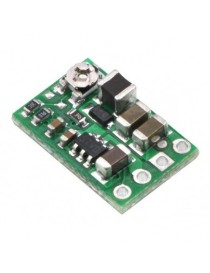

No products in the cart.


Pololu Step-Down Voltage Regulator D24V6ALV
"
The compact (0.4? × 0.6?) D24V6ALV switching step-down (or buck) voltage regulator takes an input voltage between 4.5 V and 42 V and efficiently reduces it to a lower, user-adjustable voltage. It has a output voltage range of 2.5 V to 7.5 V and a maximum output current of 600mA. The pins have a 0.1? spacing, making this board compatible with standard solderless breadboards and perfboards.
These adjustable buck (step-down) voltage regulators generate lower, user-adjustable output voltages from a wide input voltage range of 4.5 to 42 V. They are switching regulators (also called switched-mode power supplies (SMPS) or DC-to-DC converters) and have a typical efficiency of 80%, which is much more efficient than linear voltage regulators, especially when the difference between the input and output voltage is large. The output voltage is set using the board’s trimmer potentiometer, with the two D24VxALV versions having an available range of approximately 2.5 V to 7.5 V and the two D24VxAHV models having an available range of approximately 4 V to 25 V. Versions with 300 mA and 600 mA maximum output currents are available:
Select options:We also offer versions of this regulator with fixed output voltages:
Select options:The regulator has short-circuit protection, and thermal shutdown prevents damage from overheating. The board does not have reverse-voltage protection.
The buck regulator has four connections: shutdown (SHDN), input voltage (VIN), ground (GND), and output voltage (VOUT).
The SHDN pin can be driven low (under 0.3 V) to turn off the output and put the board into a low-power state that typically draws 20 ?A, and it can be driven high (above 2.3 V) to enable the board. If you do not need to use the shutdown feature, the SHDN pin can be directly connected to VIN to permanently enable the board. You should not leave this pin disconnected as this can result in unpredictable behavior.
The input voltage, VIN, should be between 4.5 V and 42 V. If the input voltage gets too close to the output voltage, the output will start to drop, so you should ensure that VIN is at least a few volts above VOUT. You should also ensure that noise on your input does not exceed the 42 V maximum, and you should be wary of destructive LC spikes (see below for more information).
The output voltage, VOUT, is determined by the trimmer potentiometer position. Setting the output voltage to be higher than the input voltage will not damage the board, but it will produce an oscillating output rather than a clean power rail (see the oscilloscope capture below), so we recommend you avoid setting the output voltage to be higher than the input voltage. The available output voltage range depends on your input voltage, VIN, and the regulator version you have: 2.5 V to 7.5 V (D24VxALV) or 4 V to 25 V (D24VxAHV). The maximum available output current also depends on your regulator version: 300 mA (D24V3Axx) or 600 mA (D24V6Axx). Exceeding the maximum output current can cause the output voltage to drop below its set value.
|
VOUT of the Pololu step-down regulator D24V3ALV when VIN is 5 V and the output voltage setting is higher than 5 V. |
|---|
The four connections are labeled on the back side of the PCB, and they are arranged with a 0.1? spacing along the edge of the board for compatibility with solderless breadboards, connectors, and other prototyping arrangements that use a 0.1? grid. You can solder wires directly to the board or solder in either the 4×1 straight male header strip or the 4×1 right-angle male header strip that is included.
The output voltage can be measured using a multimeter. Turning the potentiometer clockwise increases the output voltage. The output voltage can be affected by a screwdriver touching the potentiometer, so the output measurement should be done with nothing touching the potentiometer. When setting the output voltage, note that the buck regulator can only produce voltages lower than the input voltage.
|
Output voltage settings for the adjustable 2.5-7.5V and 4-25V buck regulators (D24VxAxx). |
|---|
|
Typical available output current of Pololu step-down voltage regulator D24V3Axx. |
|---|
When connecting voltage to electronic circuits, the initial rush of current can cause voltage spikes that are much higher than the input voltage. If these spikes exceed the regulator’s maximum voltage (42 V), the regulator can be destroyed. In our tests with typical power leads (~30? test clips), input voltages above 20 V caused spikes over 42 V. If you are connecting more than 20 V or your power leads or supply has high inductance, we recommend soldering a 33?F or larger electrolytic capacitor close to the regulator between VIN and GND. The capacitor should be rated for at least 50 V.
More information about LC spikes can be found in our application note, Understanding Destructive LC Voltage Spikes.
"